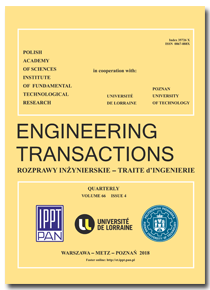10.24423/EngTrans.3404.2024
Investigation of the Impact of Epoxy-based Composites Reinforced with Betel Nut and Coir Fiber on Physio-Mechanical Properties
Natural fibers are increasingly being used in composite production due to the detrimental effects of synthetic fibers on the environment and public health. Compared to synthetic fibers, natural fibers are more easily manufactured, less expensive, and contribute significantly to the mechanical properties of composites. This study investigates the impact of natural fibers on the mechanical and physical properties of fabricated composites. The epoxy-based composite in this work was reinforced with betel nut and coir fiber, using a hand lay-up technique as the fabrication method. During the composite fabrication, resin and hardener were used at a constant weight ratio of 80%. The length of the coir fiber ranging between 15 mm to 50 mm, and the weight percentage (wt.%) of coir fiber and betel nut fiber in the composite, ranging from 5% to 15%, were used as control factors. After testing and analyzing nine different samples, it was observed that impact strength (9.5 J/cm2), and tensile strength (4.4 MPa) were higher for 15% of coir fiber and 5% of betel nut fiber, regardless of coir fiber length. Irrespective of coir fiber length, flexural strength and hardness increased as the betel nut fiber content rose from 5% to 15%. The highest flexural strength of 1.0 MPa and hardness of 68 RHN (Rockwell hardness number) were recorded for sample 4. During the water absorption test, sample 1 with a coir fiber length of 50 mm, 5% of coir fiber and 15% of betel nut fiber showed significant performance with a 0.07% water absorption rate. These natural fiber-based composites can be utilized in the fabrication of different types of mats, bags, and clothing items.
References
TWI Ltd, What is a composite material? (A definitive guide), https://www.twi-global.com/technical-knowledge/faqs/what-is-a-composite-material (retrieved on 30.08.23).
Ngo T.-D., Composite and Nanocomposite Materials: From Knowledge to Industrial Applications, IntechOpen Limited, London, UK, 2020, doi: 10.5772/intechopen.80186 (retrieved https://www.intechopen.com/books/8768).
Gupta G., Kumar A., Tyagi R., Kumar S., Application and future of composite materials: A review, International Journal of Innovative Research in Science, Engineering and Technology, 5(5): 6907–6911, 2016, doi: 10.15680/IJIRSET.2016.0505041.
Boda M.A., Phand R.V., Kotali A.C., Metal and non-metal composite materials a new alternative for materials: Review, International Journal of Scientific Development And Research, 2(4): 236–239, 2017, https://ijsdr.org/papers/IJSDR1704040.pdf.
Huzaifa W., Coconut / Coir Fiber: Properties, Manufacturing Process and Uses, Textile Learner, 2020, https://textilelearner.net/coconut-coir-fiber-properties-manufacturing/ (retrieved on 03.09.23).
Yan Y., Developments in fibers for technical nonwovens, [In:] 2-Advances in Technical Nonwovens, Kellie G. [Ed.], pp. 19–96, Woodhead Publishing Series in Textiles, 2016, doi: 10.1016/B978-0-08-100575-0.00002-4.
Boopalan M., Niranjanaa M., Umapathy M.J., Study on the mechanical properties and thermal properties ofjute and banana fiber reinforced epoxy hybrid composites, Composites Part B: Engineering, 51: 54–57, 2013, doi: 10.1016/j.compositesb.2013.02.033.
Sotannde O.A., Oluwadare A.O., Ogedoh O., Adeogun P.F., Evaluation of cement- bonded particle board produced from afzelia Africana wood residues, Journal of Engineering Science and Technology, 7(6): 732–743, 2012.
Kayode J, Conservation implications of timber supply pattern in Ekiti State, Nigeria, Research Journal of Forestry, 1(2): 86–90, 2007, doi: 10.3923/rjf.2007.86.90,
Erakhrumen A.A., Areghan S.E., Ogunleye M.B., Larinde S.L., Odeyale O.O., Selected physico- mechanical properties of cement-bonded particleboard made from pine (Pinus caribaea M.) sawdust-coir (Cocos nucifera L.) mixture, Scientific Research and Essay, 3(5): 197–203, 2008.
Mendes R.F., Mendes L.M., Guimarães J.B., Jr., dos Santos Cavalcante R., Bufalino L., The adhesive effect on the properties of particleboards made from sugar cane bagasse generated in the distiller. Revista de Ciências Agrárias, 32(2): 209–218, 2009, doi: 10.19084/rca.15739.
Sekaluvu L., Tumutegyereize P., Kiggundu N., Investigation of factors affecting the production and properties of maize cob-particleboards, Waste and Biomass Valorization, 5: 27–32, 2014, doi: 10.1007/s12649-013-9228-9.
Bekalo S.A., Reinhardt H.W., Fibers of coffee husk and hulls for the production of particleboard, Materials and Structures, 43(8): 1049–1060, 2010, doi: 10.1617/s11527-009-9565-0.
American National Standard for Particleboard. ANSI/A208.1. Composite Panel Association, Gaithersburg, 1999, https://www.scribd.com/doc/286962476/ANSI-A208-1-1999-PB.
Amenaghawon N.A., Osayuki-Aguebor W., Okieimen C.O., Production of particle boards from corn cobs and cassava stalks: Optimisation of mechanical properties using response surface methodology, Journal of Materials and Environmental Science, 7(4): 1236–1244, 2016.
Boquillon N., Elbez G., Schönfeld U., Properties of wheat straw particleboards bonded with different types of resin, Journal of Wood Science, 50: 230–235, 2004, doi: 10.1007/s10086-003-0551-9.
Chakrabarty J., Hassan M.M., Khan M.A., Effect of surface treatment on betel nut (Areca catechu) fiber in polypropylene composite, Journal of Polymers and the Environment, 20: 501–506, 2012, doi: 10.1007/s10924-011-0405-2.
Song M., Yu H., Gu J., Ye S., Zhou Y., Chemical cross-linked polyvinyl alcohol/cellulose nanocrystal composite films with high structural stability by spraying Fenton reagent as initiator, International Journal of Biological Macromolecules, 113: 171–178, 2018, doi: 10.1016/j.ijbiomac.2018.02.117.
Prabhu R., Joel C., Bhat T., Development and characterization of low-cost bamboo fibre reinforced polymer composites, American Journal of Materials Science, 7(5): 130–134, 2017, doi: 10.5923/j.materials.20170705.02.
Hossain M.A., Rashid F., Akhter M.S., Aziz M., Hoque M.E., Liquid fuel generation from onion shell: an experimental approach of pyrolysis process, Energies, 17(9): 2171, 2024, doi: 10.3390/en17092171.
Mittal M., Chaudhary R., Biodegradability and mechanical properties of pineapple leaf/coir fiber reinforced hybrid epoxy composites, Materials Research Express, 6(4): 045301, 2019, doi: 10.1088/2053-1591/aaf8d6.
Naik A.B., Reddy A.C., Optimization of tensile strength in TIG welding using the Taguchi method and analysis of variance (ANOVA), Thermal Science and Engineering Progress, 8: 327–339, 2018, doi: 10.1016/j.tsep.2018.08.005.
Dahal R.K., Acharya B., Dony B., Dutta A., Biocarbon filled hemp-epoxy composite: its physical, mechanical, and thermal properties, Applied Composite Materials, 29(6): 2185–2202, 2022, doi: 10.1007/s10443-022-10059-8.
Li H., Wang T., Sun J., Yu Z., The effect of process parameters in fused deposition modelling on bonding degree and mechanical properties, Rapid Prototyping Journal, 24(1): 80–92, 2018, doi: 10.1108/RPJ-06-2016-0090.
Gowda R.B.S., Udayagiri C.S., Narendra D.D., Studies on the process parameters of rapid prototyping technique (Stereolithography) for the betterment of part quality, International Journal of Manufacturing Engineering, 2014(1): 804705, 2014, doi: 10.1155/2014/804705.
Foley M.E., Hart D.C., Guidelines for developing and inserting material properties into the code 65 composite material database, West Bethesda, MD: Naval Surface Warfare Center, Carderock Division, 2011, https://apps.dtic.mil/sti/citations/ADA579199.
DOI: 10.24423/EngTrans.3404.2024





